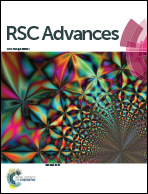Fe-promoted oxidative cyclization of α-benzoylthioformanilides for the synthesis of 2-benzoylbenzothiazoles†
Abstract
2-Benzoylbenzothiazoles were obtained in good yields via an efficient synthesis involving oxidative cyclization of α-benzoylthioformanilides catalyzed by FeCl3. This protocol has the advantages of short reaction times, moderate to good yields, convenient manipulation, and high selectivities.


 Please wait while we load your content...
Please wait while we load your content...